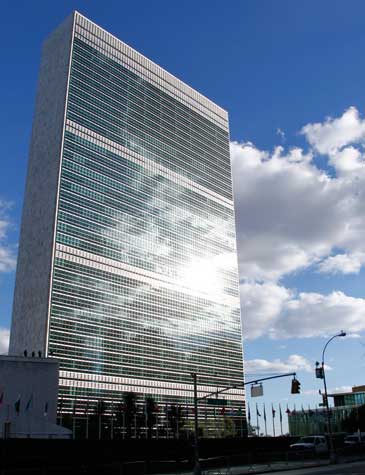
“I would like to see our renovated Headquarters complex eventually become a globally acclaimed model of efficient use of energy and resources. Beyond New York, the initiative should include the other United Nations headquarters and offices around the globe.”
Secretary-General Ban Ki-moon
Speech on World Environment Day 2007
In 2007, on World Environment Day (5 June), Secretary-General Ban Ki-moon, with the above words, made public his ambition to make the United Nations more efficient in its operations. In October 2007, at the meeting of the UN System Chief Executives Board for Coordination (CEB), the Executive Heads of UN agencies, funds and programmes committed to move their respective organizations towards climate neutrality, and developed the UN Climate Neutral Strategy.
Specifically, they committed to:
- Estimate the greenhouse gas emissions of UN system organizations consistent with accepted international standards;
- Undertake efforts to reduce greenhouse gas emissions;
- Analyze the cost implications and explore budgetary modalities of purchasing carbon offsets to eventually reach climate neutrality.
The UN Climate Neutral Strategy highlights the advantages of harmonization. A common approach across the UN system brings greater impact, lowers transactions costs, facilitates practical action on the ground through the development of common tools, ensures comparability of data across organizations, and pooling of results for better-informed decisions and knowledge-sharing.
Greenhouse gas emissions of UN organizations and what we are doing to reduce them
Information provided by the United Nations Environment Programme (UNEP) Sustainable United Nations team shows that the United Nations (UN) system hasoffset 17% of its reported greenhouse gas emissions for 2013, a positive step towards meeting Secretary General Ban Ki-moon’s ambitious target of the UN system to be climate neutral by 2020.
The news comes as the United Nations Framework Convention on Climate Change (UNFCCC) launches its Climate Neutral Now initiative, which encourages and enables organizations, companies and individuals to measure, reduce and offset their emissions direct with UN-certified climate credits.
A significant effort has been underway in the UN since 2007, when organizations approved the UN Climate Neutral Strategy, which commits all UN organizations to measure, reduce and then offset any greenhouse gas emissions that cannot be avoided. The UN has been measuring its greenhouse gas emissions from facilities and travel since 2009 and in 2013 emitted at least 1,7 million tonnes of carbon dioxide equivalent.
A total of nine UN-system organizations achieved climate neutrality for 2013 by measuring, reducing and offsetting their greenhouse gas emissions. An additional two organizations offset emissions from their headquarters for the same period.
Greening the Blue
Greening the Blue is the official United Nations platform for raising awareness about the importance of sustainability within the UN system. The website highlights what has been achieved, what is happening next, and how UN staff can get involved.
Aiming to improve communications on the UN system's sustainability performance, the website is a reservoir of useful information, including:
- The greenhouse gas inventories of most UN organizations;
- Case studies from different UN organizations on their internal sustainable activities;
- An animation showing how UN staff help create a more sustainable workplace;
- Resources containing tips and tools for the reduction of carbon footprint
Greening the Blue is a one-stop shop for UN staff and the general public who have an interest in creating a more sustainable United Nations.
